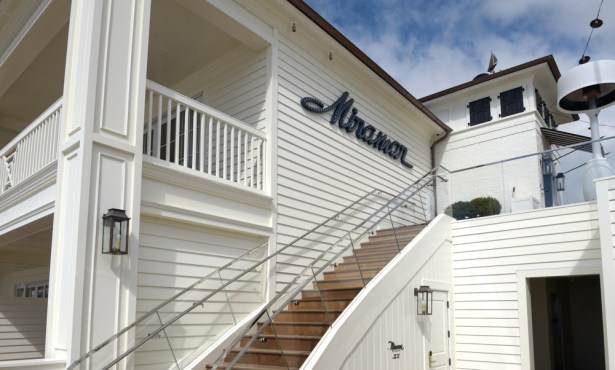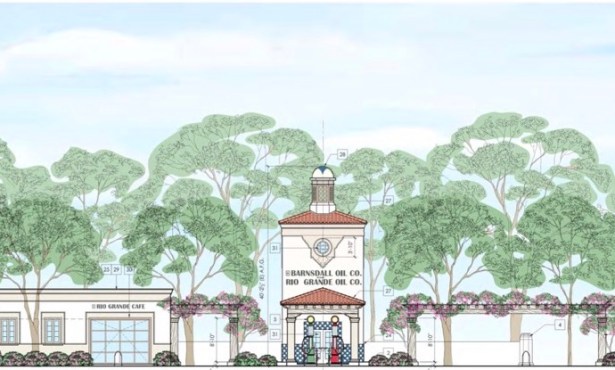Height Fight on Chapala
What's Greener: Cute Little Buildings, or Big Tall Ones?
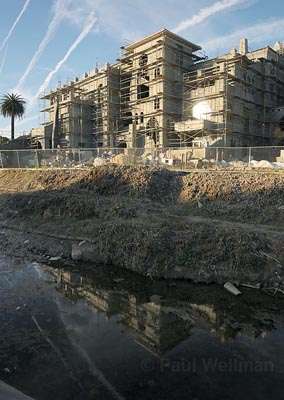
Amassing tall condo developments in downtown Santa Barbara, atop ground-floor offices and shops, will preserve from development the oak-studded hills of the Gaviota Coast north of the urban limit line. So say defenders of the 60-foot buildings that are going up on Chapala Street. Over the past several years, the city’s planning department has come to embrace the philosophy of “smart growth” as an alternative to sprawl, placing high-density apartment complexes and mixed-use projects in the commercial corridors, with the blessing not only of developers and housing advocates but also the Sierra Club and the Community Environmental Council. “Most environmental groups support the idea of a vital, lively urban core with people living in it, close to jobs and services, to preserve open space outside the city,” said Detlev Peikert, architect of the Bermant Development Company’s Paseo Chapala, which reaches heights of 50 feet. Completed in 2007, Paseo Chapala mirrors the Paseo Nuevo mall, which is directly across the street, except that its upper floors house 21 luxury condos and eight affordable condos.

Building skyward to add more housing is better than building outward, Peikert said. “It’s a more environmentally sound use of land and energy resources.” People living in the city don’t have to commute, he explained, which saves gas. “It’s sort of a no-brainer on that level,” Peikert said. “It’s hard to argue for a more suburban model in the urban core,” which would necessitate a push into the countryside to find space for new housing, he said.
There is little doubt that Santa Barbara will have to create new housing. The state mandates that each region provide a certain number of new homes each year in order to accommodate its “fair share” of California’s population, which grows by about a half-million people each year. For another, the city offered to absorb some of the building that would otherwise occur in Gaviota by making deals to transfer landowners’ development rights from countryside to city.
Yet Paseo Chapala initiated the conversion of Chapala Street from an off-State Street haven for mom-and-pop shops-Juan Lara Saddlery, a locally owned boutique and beauty shop, a corner grocery-to a distinctly urban corridor. The project also set off a reaction against what critics have dubbed the “canyonization” of Chapala-a reaction that gained critical mass with the construction three blocks down of the even-bigger Chapala One, which is 60 feet high and almost a block long. Nestled against Mission Creek, it bears 46 homes on its top three stories, 11 of them affordable. In its later phases of construction, Chapala One has sprouted bouquets of exterior detailing, from blue-tiled alcoves to unique terra-cotta moldings, intended by the architectural firm Design Arc to charm pedestrians. If critics had been aware beforehand of the building’s beautiful skin, perhaps that would have tempered their criticism-though probably not. In any case, by the time these stylings materialized, the opposition had already sprung into action, led by former city office holders.
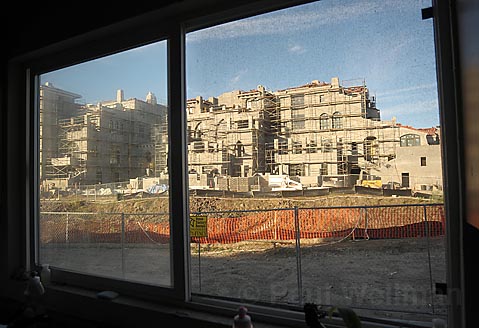
Bring It Down
Architect Don Sharpe, who had retired from public life after 13 years on the Architectural Board of Review and eight years on the Historic Landmarks Committee (HLC), immediately re-applied to the HLC and was reappointed at the beginning of 2007. He has been using his position to obstruct such projects by any means necessary. Former mayors Sheila Lodge and Harriet Miller as well as former planning commissioner Bill Mahan are busily heading up a petition drive to lock into the city’s charter a 40-foot height limit in El Pueblo Viejo.
The city’s historic district and its main commercial zone, Pueblo Viejo comprises a rectangle bordered by the downtown streets of Sola and Ortega, Chapala and Laguna, with extensions along Chapala, State, and Carrillo. The former mayors’ charter amendment would also impose a 45-foot limit in the rest of the city’s commercial areas. It would lock into the charter the existing 30-foot height limit, now decreed by ordinance, for single-family and two-family residential zones. Both of these, along with a 60-foot limit in Pueblo Viejo, are currently decreed by ordinance. A second petition, being circulated by longtime civic activist Jim Kahan, would charter a three-story, 38-foot height limit throughout the city. Petitioners will need about 7,000 signatures to get their charter amendments onto the November 8 ballot, where they will require approval by a simple majority of voters in order to pass.
During a City Council meeting in early March, Councilmember Helene Schneider publicly pleaded for the petitioners to hold off and to just participate in Plan Santa Barbara-a series of vision-drafting workshops to form policies ultimately to be folded into the city’s update of its general plan in 2010-but to no avail. With 13 more projects more than 40 feet in height already in the Pueblo Viejo planning pipeline, the petitioners said that two years is too long to wait.
Not that they’re entirely opposed to density downtown. Everybody, on all sides of the height question, loves El Carrillo, a three-story, 35-foot-tall housing project on Carrillo Street that fits 62 studio apartments on a half-acre of land. El Carrillo incorporates actual nature-not just potted plants but earth, insects, trees, and seasons-in its interior courtyard, a design concept on many California architects’ list of favorites. However, its gracious outdoor spaces are made possible only by the waiver of all parking requirements and the small size of its apartments-254 square feet each, reserved for people who were formerly homeless. City designers of all stripes also swoon over Casa de Las Fuentes, a 42-unit project just down the street from El Carrillo, designed by Peikert, which also has an inner garden as well as large decks on the upper floors. Its apartments are reserved for downtown workers without cars. Other high-density projects almost universally admired include Casas Las Granadas, 12 affordable apartments encrusted on the outside of the Granada Parking Garage, and the greenery-ringed Garden Court Apartments on De la Vina Street, which provide 97 affordable units for seniors. Both Casas Las Granadas and Garden Court Apartments are also Peikert projects. None require much parking, and all four were funded by government and private grants.
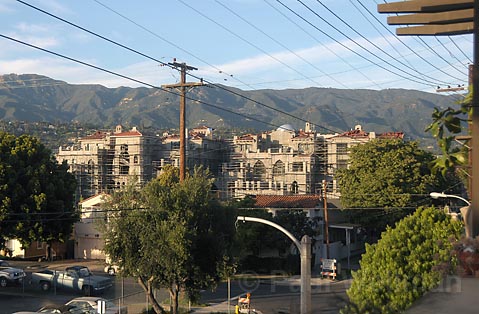
Earth and sky
The Chapala developments are an entirely different story, however. Too massive to blend with the city’s historic downtown, they are not the kind of things tourists come to see, say petitioners. And tourism is the city’s economic base. “Here we are building Pueblo Viejo to look like Orange County and Van Nuys and saying, ‘Now come visit us,'” said architect and former planning commissioner Fred Usher. Yes, Santa Barbara has to house the workers who make the tourist economy work, Usher agreed, but can do so without huge buildings. “In fact, there’s not a square foot of children’s play area in all of Paseo Chapala,” said architect Don Sharpe. “You’re going to get kids bouncing balls in halls against the doors of those $2-million condos.”
Developers contend that the only way they can subsidize affordable housing with their projects, as the city requires, is by spreading the cost among a large number of luxury condominiums. Former planning commission Mahan and other critics of the large condo projects beg to differ.
“You wouldn’t have to build property line to property line and 60 feet high to fit affordable [units] if you limited the square footage of the units,” Mahan insisted, seated at a conference table with Lodge and Sharpe as they pitched their case to this reporter. “Architects go around saying they can’t do it in 40 feet,” said Mahan, “but that’s not the truth, and we know because we are architects,” he said, nodding at Sharpe. “They can do it within 40 feet and make it more compatible and more beautiful.” The only thing stopping them is their clients’ attention to maximizing the bottom line, even though, according to these architects, profits on luxury condominiums are enormous. According to Mahan, they typically sell for more than twice what they cost to build.
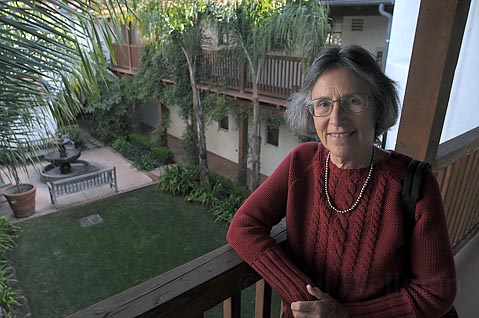
True, the smaller projects would not be worth as much money, which would probably reduce the cost of the land. That, according to Lodge, would be a good thing. The review process would be speedier and therefore less expensive for less massive buildings, petitioners said, “because the Historic Landmarks Commission and the Planning Commission won’t be fighting tooth and nail with developers.”
The petitioners also took issue with the generally accepted view that tall buildings are greener than short ones because they shed less heat. Lodge and Mahan were scandalized by a newspaper ad for Paseo Chapala that boasted of ceilings 13 to 17 feet high; they estimated that the added square footage would increase heating costs by two-thirds or more compared to eight- or nine-foot ceilings. Moreover, they said, residential projects in mixed-use buildings are allowed to come all the way to the property line-and trying to persuade developers to move them back even a few inches is a major battle-yet windows on a property line cannot be opened, according to state building codes. That means there can be no cross ventilation to cool the building with fresh air. “How sustainable is that?” Sharpe demanded.
Last but not least, the petitioners challenge the contention that large condo developments in the city will prevent sprawl into rural areas. Lodge noted that San Francisco’s tall buildings, meritorious as they may be for other reasons, have not prevented city workers from commuting into the city from as far afield as Santa Rosa and Palo Alto. “If you build one,” declared Sharpe, “10 more will come.”
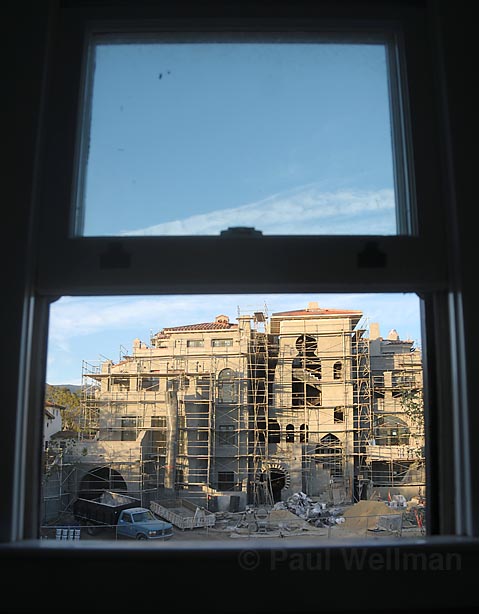
Getting Medieval
“I’m not sure what people are so afraid of,” Peikert responded. “Some of the most beautiful cities in the world have three-, four-, five-story buildings in the urban core. Go to a European medieval town, and there are many taller buildings, even in that small town, but it’s surrounded by open space; it’s how they conserve open space.” It might not happen automatically, he said, but it can happen with careful planning. Most critics will come to appreciate Paseo Chapala’s beauty when the ground floor commercial spaces are occupied and the trees get larger. And as for eight-foot ceilings, Peikert said, they were born in the ’50s and ’60s in a suburban setting. “When you are surrounded by backyards if might be okay,” Peikert said, “but in an urban environment, it’s important to provide the maximum amount of air and light and sense of space. Most of our buildings downtown have tall ceilings-you wouldn’t want an eight-foot ceiling in a store on State Street, it wouldn’t be enjoyable. Nine feet, okay. But eight feet? I’ve been to offices with eight-foot ceilings and immediately know I don’t want to spend eight hours a day sitting around in this space. It’s a little oppressive.”
“It’s too late to make Santa Barbara a medieval village,” Usher retorted. City dwellers need green space-beyond potted plants-close to home. Luxury condos in the core will push people outward, increasing pressure on the surrounding neighborhoods to build out to their 12-unit-per-acre maximum. Presuming everybody has to have off-street parking, will nature-loving Santa Barbarans really be content to reside in an all-concrete environment, he asked, or will they push ever outward into suburbs?
To bring more nature back into the urban environment, Peikert recommended that the city encourage rooftop gardens. “In fact we are now trying to incorporate it into all our urban projects. But do you know,” he said, “that there are some on the HLC who abhor roof gardens. Apparently they are worried that someone might have an umbrella which shows liveliness and life downtown.” Peikert might easily have been talking about Sharpe, who explained that his problem with roof gardens is that they “tend to turn into fourth stories,” what with tall trellising, plus stairwells and elevators, which project another 10 feet above roof level.
Peikert also suggested that the city could acquire more parkland in the urban core, though he admits that it would have been a lot cheaper a few years ago. Besides the desirability of interior courtyards, that’s another point on which Peikert sees eye to eye on with the tall-condo critics, who couldn’t agree more. “That’s the direction the city should go,” Usher said.
“So it really is in flux,” Peikert said, “as everybody tries to figure out what we want.”

